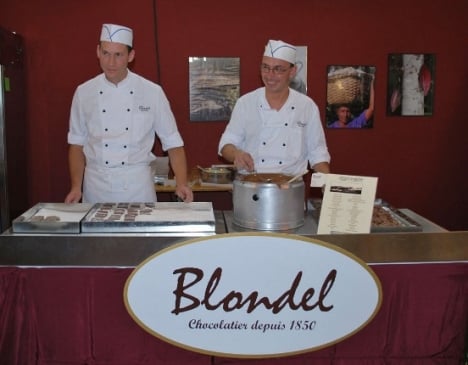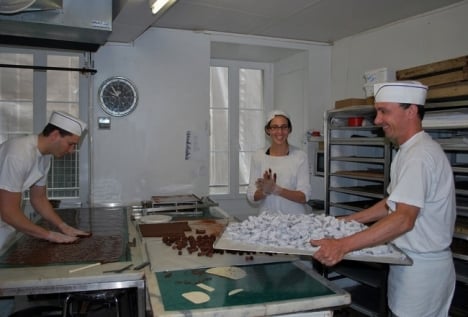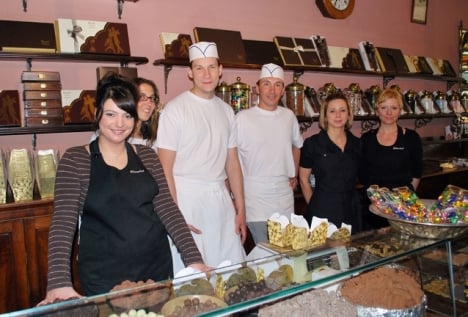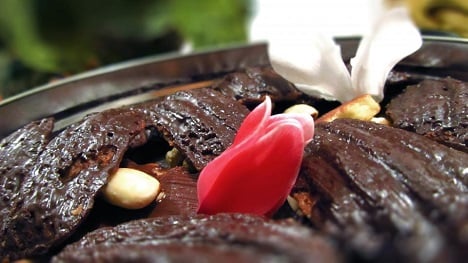If it’s not broken, don’t fix it.
There’s a reason that Blondel chocolaterie has been using the same techniques and traditions since 1850.
“This was the first chocolate factory in Lausanne, founded in 1850 by Adrien Blondel,” maitre chocolatier Bastien Thibeau tells The Local.
It was an instant hit, and not just with the locals.
“Many English people came to try the chocolate,” Thibeau says. “We even sent chocolate to the family of Winston Churchill. We still have the order.”

Bastien Thibeau and a colleague at work. Photo: Blondel
The clientele is no less impressive today, and spans the globe. The cute little shop on the hill at Rue de Bourg 5, where it’s been for more than a century, is the number one stop for shoppers in Lausanne and has glowing reviews from tourists and locals alike.
“This could be the best chocolate you will ever taste,” one man gushes, noting that “lucky tourists” who find it get the experience of a lifetime. “Worth the trek uphill”, another exclaims. “The long line of locals” is proof of its quality, an American writes. Even the French worship Blondel.
It’s not a big shop. Chocolate bark garnishes one wall and showcases of delectable concoctions light up the other. Candied fruits and chocolate in every shade greets the hungry eyes of visitors.
Swiss chocolate is the best in the world, and it’s said Blondel is the best chocolate in Lausanne. You do the math: this stuff is edible gold.
Thibeau says that the secret to Switzerland’s chocolate is a long history of experimentation – and Blondel’s has been in the game almost since the beginning.
“The Swiss have invented a lot of chocolate-related things,” he explains. “The first chocolate factory, Cailler, which is now Nestle, was established in 1819. I suppose it’s a mixture of knowledge, experimenting, and experience.”
Blondel itself has been on the cutting edge of confection innovations. The famous chocolatier was chosen to create mini chocolate shoes for the 25th anniversary of Nike’s Air Force trainer shoes, and the company has collaborated with many other big brands as well.
So what’s Blondel’s own secret?
Today Thibeau, who has worked at Blondel for 13 years,is in charge of guarding the company’s precious reputation.
“It’s the simplicity that stands out about Blondel,” the chief chocolatier says. “We like to create chocolate the traditional way, so we use few ingredients.”
He says the focus is on taste: he uses all-natural ingredients, with no preservatives or colours added.
“We also have a large selection and offer a variety of flavours and mixtures, including tastes you won’t find anywhere else.”
Hazelnut, figs, almond, ginger, orange, apricot and cinnamon are just a small sample of the options available, he says.

Indeed, the variety is one of the best parts of the job.
“I get to create every day,” Thibeau, who makes all the chocolates by hand along with his three employees, explains. “It’s never the same thing, it’s always changing.”
Blondel also uses local ingredients – other than the cocoa beans themselves, of course.
“We use all different kinds. We’ve sourced cocoa beans from Asia, Central America, and Africa,” Thibeau says.
But their specialty – and according to Thibeau, their very best product – is old-style truffles.
“Truffes à l’ancienne,” he clarifies. “They are very special, artisanal.”
Yes, life as a chocolatier is sweet indeed. But how does one find that calling, and make it a reality?
For Thibeau it all started when he was 15.
“I did an internship at a chocolate factory near my home. I loved being able to create, and to make people happy,” he says.
He went on to do an apprenticeship, as everyone must in order to earn such a prestigious title.

“You have to do an apprenticeship for three years, during which you learn the art of pastry and confectionary-making,” he explains. “You also learn how to make chocolate and ice-cream, and then you can choose a specialty for two years.”
Spoiler alert: He chose chocolate.
“Chocolate is a fantastic material to work with,” he exclaims. “You can innovate all the time, mix with other products – there’s always something new you can do, always a new flavour, always more to learn.”
But if he had to pick just one?
“I don’t have a favourite. Though I really like the chocolate bar with dark chocolate and pistachio and one with caramel,” he confesses after a long, hard think. “But there are so many!”

All photos: Blondel
This article was produced by The Local in partnership with Blondel.




 Please whitelist us to continue reading.
Please whitelist us to continue reading.